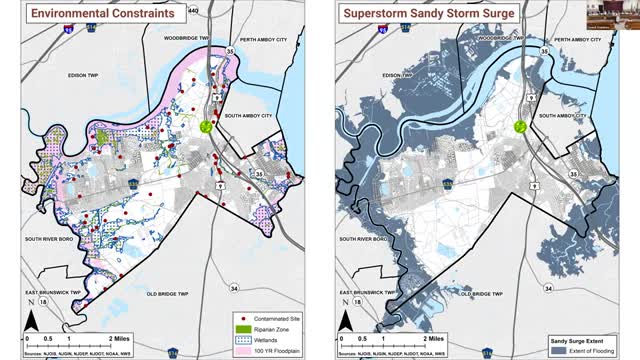Borough plans bold upgrades for flood resilience and safety
August 08, 2024 | Sayreville, Middlesex County, New Jersey
This article was created by AI summarizing key points discussed. AI makes mistakes, so for full details and context, please refer to the video of the full meeting. Please report any errors so we can fix them. Report an error »

In a recent government meeting, officials from Sayreville discussed critical infrastructure and environmental planning initiatives aimed at enhancing community resilience and safety. The meeting highlighted the borough's unique geographical challenges, including extensive waterways and wetlands, which significantly influence land use and development strategies.
A detailed presentation showcased maps illustrating flood zones, contaminated sites, and the impact of Superstorm Sandy, emphasizing the need for informed planning to mitigate future flooding risks. Officials noted that many contaminated sites are currently undergoing remediation, underscoring the importance of environmental sensitivity in development applications.
The circulation plan element was a focal point of the discussion, aimed at improving transportation within the borough. Data-driven analyses revealed crash hotspots along major corridors, prompting recommendations for enhanced pedestrian and cyclist safety measures. The plan also proposed the integration of green infrastructure, such as rain gardens, to manage stormwater effectively.
Community facilities were another key topic, with officials gathering input from various department heads to identify challenges and future needs. Recommendations included the potential development of a new community center for seniors and strategies to enhance police department capabilities, particularly regarding electric vehicle infrastructure.
The meeting concluded with a call for ongoing assessments of community facilities to ensure they meet the demands of a growing population. As Sayreville continues to expand, officials emphasized the importance of adapting infrastructure and services to support residents effectively. The discussions reflect a proactive approach to urban planning, prioritizing safety, sustainability, and community engagement.
A detailed presentation showcased maps illustrating flood zones, contaminated sites, and the impact of Superstorm Sandy, emphasizing the need for informed planning to mitigate future flooding risks. Officials noted that many contaminated sites are currently undergoing remediation, underscoring the importance of environmental sensitivity in development applications.
The circulation plan element was a focal point of the discussion, aimed at improving transportation within the borough. Data-driven analyses revealed crash hotspots along major corridors, prompting recommendations for enhanced pedestrian and cyclist safety measures. The plan also proposed the integration of green infrastructure, such as rain gardens, to manage stormwater effectively.
Community facilities were another key topic, with officials gathering input from various department heads to identify challenges and future needs. Recommendations included the potential development of a new community center for seniors and strategies to enhance police department capabilities, particularly regarding electric vehicle infrastructure.
The meeting concluded with a call for ongoing assessments of community facilities to ensure they meet the demands of a growing population. As Sayreville continues to expand, officials emphasized the importance of adapting infrastructure and services to support residents effectively. The discussions reflect a proactive approach to urban planning, prioritizing safety, sustainability, and community engagement.
View full meeting
This article is based on a recent meeting—watch the full video and explore the complete transcript for deeper insights into the discussion.
View full meeting
